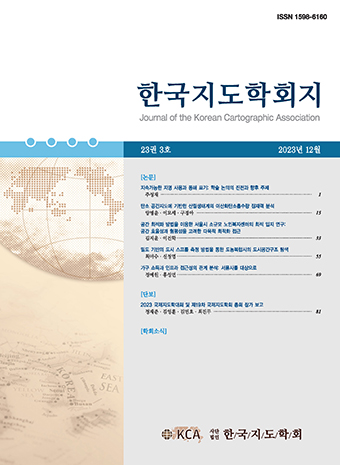Research Article
Abstract
References
Information
The pedestrian environment is a very important element in the daily life of citizens as both an individual domain and a public space. As the importance of the pedestrian environment has been recognized, a systematic survey is needed at the national level, such as stipulating by law that local governments across the country conduct a survey of the pedestrian environment every five years. However, the survey on the pedestrian environment does not deviate from the existing limitations in the survey methodology, such as relying on field surveys in some areas. This study aimed to develop a walkability evaluation index using high-resolution streetview images and deep learning technology. To develop a walkability evaluation index, a draft of the walkability evaluation index was developed based on a review of domestic and foreign literature and a study on the evaluation of the walkability using deep learning technology. In order to confirm the possibility of constructing the derived walkability evaluation index, the final index was proposed after examining the accuracy of the result of semantic segmentation of streetview images and the possibility of obtaining necessary data. As for the derived walkability evaluation indicators, it was suggested to use 8 indicators in 4 categories: safety, convenience, comfort, and accessibility. The results of this study break away from the limitations of existing walkability studies based on field observation surveys and surveys, provide an opportunity for intelligent urban research using high-resolution streetview images and deep learning technology, and perform pedestrian environment evaluation tasks more efficiently.
보행환경은 개인의 영역이자 공공 공간으로서 시민들의 일상생활에 매우 중요한 요소이다. 보행환경의 중요성이 인지되면서 국가적 차원에서도 보행환경 실태조사를 전국 지자체가 5년마다 시행하도록 법으로 규정하는 등 체계적인 실태조사가 필요한 실정이다. 하지만 보행환경에 대한 실태조사는 일부 지역을 대상으로 현장 조사에 의지하는 등 실태조사 방법론에 있어서는 기존의 한계를 벗어나지 못하고 있다. 본 연구는 고해상도 거리 영상과 딥러닝 기술을 활용한 보행환경 평가 지표 개발을 목표로 하였다. 보행환경 평가 지표 개발을 위해 보행환경 평가와 관련된 국내외 문헌 및 딥러닝 기술을 활용한 보행환경 평가 연구를 리뷰를 토대로 보행환경 평가 지표 초안을 개발하고, 도출된 보행환경 평가 지표의 구체적 데이터 구축 가능성을 확인하기 위해 거리 영상의 시멘틱 세그멘테이션(semantic segmentation) 결과 정확도와 영상 외 필요한 자료에 대한 취득 가능성을 검토한 후 최종 보행환경 평가 지표를 제안하였다. 도출된 보행환경 평가 지표는 안전성, 편리성, 쾌적성, 접근성 4개 카테고리에 8개 지표를 활용하는 것을 제안하였다. 본 연구의 결과는 현장 관찰 조사나 설문조사에 기반한 기존 보행환경 연구의 한계점을 탈피하고 고해상도 거리 영상과 딥러닝 기술을 활용한 도시 연구의 지능화 계기를 마련하고 보행환경 평가 업무를 보다 효율적으로 수행할 수 있는 초석이 될 것으로 기대한다.
- 김수봉・정응호・전은정, 2006, “보행자 만족도 분석을 통한 가로환경 개선 계획: 대구광역시 호림로를 중심으로,” 환경과학논문, 11(1), 205-218.
- 김규리・이제선, 2016, “보행공간 요소에 대한 보행자의 인지 및 보행 만족도에 관한 연구,” 한국도시설계학회지, 17(3), 89-103. 10.7583/JKGS.2017.17.6.103
- 박근덕・이수기, 2018, “근린환경특성과 일상보행활동 그리고 주관적 건강수준의 구조적 관계 분석: 경로모형의 적용,” 국토계획, 53(1), 255-272. 10.17208/jkpa.2018.02.53.1.255
- 박소현・최이명・서한림・김준형, 2009, “주거지 보행환경 인지가 생활권 보행만족도에 미치는 영향에 관한 연구,” 대한건축학회지-계획계, 25(8), 253-261.
- 박철영・이수기, 2016, “가로환경 특성이 보행자 교통사고에 미치는 영향 분석: 가로 세그먼트 분석단위와 공간통계모형의 적용,” 한국도시설계학회지, 17(3), 105-121.
- 박효숙・이우민・김승남・이경환, 2019, “근린의 보행친화도와 주택가격의 상관관계 분석,” 한국도시설계학회지, 20(4), 75-87. 10.38195/judik.2019.08.20.4.75
- 배민경・박승훈, 2018, “무단횡단 교통사고를 유발하는 가로환경요인에 관한 연구,” 한국지역개발학회지, 30(2), 177-192.
- 서지민・이수기, 2016, “서울시 보행자 교통사고에 영향을 미치는 물리적 환경요인에 관한 연구,” 국토계획, 51(3), 197-216. 10.17208/jkpa.2016.06.51.3.197
- 이경환・안건혁, 2008, “지역 주민의 보행활동에 영향을 미치는 근린환경 특성에 관한 실증분석: 서울시 12개 행정동을 대상으로,” 대한건축학회지-계획계, 24(6), 293-302.
- 이상규・이승지・황은경・이상호, 2001, “상업지역 가로 이용자 만족요인 분석에 관한 연구,” 대한건축학회논문집, 17(9), 245-252.
- 이세영・이제승, 2014, “어린이・노인 보행자 교통안전을 위한 근린환경요인,” 한국도시설계학회지, 15(6), 4-15.
- 이수기・고준호・이기훈, 2016, “근린환경특성이 보행 만족도에 미치는 영향 분석: 서울서베이 2013년 자료를 중심으로,” 국토계획, 51(1), 169-187. 10.17208/jkpa.2016.02.51.1.169
- 이수기・이윤성・이창관, 2014, “보행자 연령대별 보행만족도에 영향을 미치는 가로환경의 특성 분석,” 국토계획, 49(8), 91-105. 10.17208/jkpa.2014.12.49.8.91
- 이수민・황기연, 2009, “보행환경요인이 보행안전에 미치는 영향 분석,” 대한교통학회지, 27(1), 107-114.
- 조혜민・이수기, 2016, “보행목적별 보행활동시간에 영향을 미치는 근린환경 특성 분석: 주관적 인지환경과 객관적 측정환경의 차이를 중심으로,” 국토계획, 51(4), 105-122.
- Blečić, I., Cecchini, A., and Trunfio, G.A., 2018, Towards automatic assessment of perceived walkability.
International Conference on Computational Science and Its Applications , 351-365. 10.1007/978-3-319-95168-3_24 - Cheng, L., Chu, S., Zong, W., Li, S., Wu, J., and Li, M., 2017, Use of tencent street view imagery for visual perception of streets,
ISPRS International Journal of Geo-Information , 6(9), 265. 10.3390/ijgi6090265 - Chen, L-C., Papandreou, G., Schroff, F., and Adam, H., 2017, Rethinking atrous convolution for semantic image segmentation,
arXiv:1706.05587 . 10.48550/arXiv.1706.05587 - Dubey, A., Naik, N., Parikh, D., Raskar, R., and Hidalgo, C.A., 2016, Deep learning the city: Quantifying urban perception at a global scale,
Proceedings of European Conference on Computer Vision , 196-212. 10.1007/978-3-319-46448-0_12 - Frank, L.D., Schmid, T.L., Salis J.F., Chapman, J., and Saelems, B.E., 2005, Linking objectively measured physical activity with objectively measured urban form: Findings from SMARTRAQ,
American Journal of Preventive Medicine , 28(2), 117-125. 10.1016/j.amepre.2004.11.001 - Gebru, T., Krause, J., Wang, Y., Chen, D., Deng, J., Aiden, E.L., and Fei-Fei, L., 2017, Using deep learning and Google street view to estimate the demographic makeup of neighborhoods across the United States,
Proceedings of the National Academy of Sciences , 114(50), 13108–13113. 10.1073/pnas.1700035114 - Ilic, L., Sawada, M., and Zarzelli, A., 2019, Deep mapping gentrification in a large Canadian city using deep learning and Google Street View,
PLOS ONE , 14(3), e0212814. 10.1371/journal.pone.0212814 30865701 PMC6415887< - Kim, S., Park, S., and Lee, J.S., 2014, Meso-or micro-scale? Environmental factors influencing pedestrian satisfaction,
Transportation Research Part D: Transport and Environment , 30, 10-20. 10.1016/j.compenvurbsys.2021.101626 - Kohavi, R. and Provost, F., 1998, Glossary of terms. Machine Learning-Special Issue on Applications of Machine Learning and the Knowledge Discovery Process,
Machine Learning , 30, 271-274. 10.1023/A:1017181826899 - Law, S., Shen, Y., and Seresinhe, C., 2017, An application of convolutional neural network in street image classification: The case study of London,
Proceedings of the 1st Workshop on Artificial Intelligence and Deep Learning for Geographic Knowledge Discovery , 5-9. 10.1145/3149808.3149810 28154456 PMC5220598 - Li, X. and Ratti, C., 2018, Mapping the spatial distribution of shade provision of street trees in Boston using Google Street View panoramas,
Urban Forestry & Urban Greening , 31, 109-119. 10.1016/j.ufug.2018.02.013 - Li, X., Santi, P., Courtney, T.K., Verma, S.K., and Ratti, C., 2018, Investigating the association between streetscapes and human walking activities using Google street view and human trajectory data,
Transactions in GIS , 22(4), 1029–1044. 10.1111/tgis.12472 - Li, Y., Yabuki, N., Fukuda, T., and Zhang, J., 2020, A big data evaluation of urban street walkability using deep learning and environmental sensors a case study around Osaka University Suita campus,
The cognitive city(AI) , 2, 319-328. - Liu, L., Wang, H., and Wu, C., 2017, A machine learning method for the large-scale evaluation of urban visual environment,
Computers, Environment and Urban Systems , 65, 113-125. 10.1016/j.compenvurbsys.2017.06.003 - Mateo-Babiano, I., 2016, Pedestrian’s needs matter: Examining Manila’s walking environment,
Transport Policy , 45, 107-115. 10.1016/j.tranpol.2015.09.008 - Naik, N., Kominers, S.D., Raskar, R., Glaeser, E.L., and Hidalgo, C.A., 2017, Computer vision uncovers predictors of physical urban change,
Proceedings of the National Academy of Sciences , 114(29), 7571-7576. 10.1073/pnas.1619003114 28684401 PMC5530649 - Nguyen, Q.C., Khanna, S., Dwivedi, P., Huang, D., Huang, Y., Tasdizen, T., and Jiang, C., 2019, Using Google street view to examine associations between built environment characteristics and US health outcomes,
Preventive Medicine Reports , 14, 100859. 10.1016/j.pmedr.2019.100859 - Quercia, D., Aiello, L.M., Schifanella, R., and Davies, A., 2015, The digital life of walkable streets,
Proceedings of the 24th international conference on World Wide Web , 875-884. 10.1145/2736277.2741631 - Salesses, P., Schechtner, K., and Hidalgo, C. A., 2013, The collaborative image of the city: Mapping the inequality of urban perception,
PLoS ONE , 8(7). 10.1371/journal.pone.0068400 - Yin, L., Cheng, Q., Wang, Z., and Shao, Z., 2015, ‘Big data’ for pedestrian volume: Exploring the use of Google Street View images for pedestrian counts,
Applied Geography , 63, 337-345. 10.1016/j.apgeog.2015.07.010 - Zhou, H., He, S., Cai, Y., Wang, M., and Su, S., 2019, Social inequalities in neighborhood visual walkability: Using street view imagery and deep learning technologies to facilitate healthy city planning,
Sustainable Cities and Society , 50. 10.1016/j.scs.2019.101605 - ADE20K, https://groups.csail.mit.edu/vision/datasets/ADE20K
- Cityscapes, https://www.cityscapes-dataset.com
- Publisher :The Korean Cartographic Association
- Publisher(Ko) :한국지도학회
- Journal Title :Journal of the Korean Cartographic Association
- Journal Title(Ko) :한국지도학회지
- Volume : 22
- No :1
- Pages :53-68
- DOI :https://doi.org/10.16879/jkca.2022.22.1.053



 Journal of the Korean Cartographic Association
Journal of the Korean Cartographic Association





